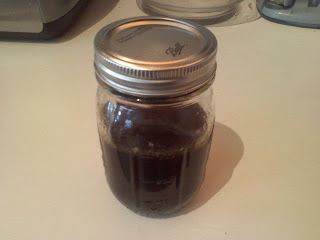Now it could be said that I am following Medical Nutrition Therapy (MNT) for diabetes guidelines. There is no such thing as "good" or "bad" food. Food is either "healthy" or "unhealthy." Also, many "healthy" foods become "unhealthy" based on the frequency and serving size consumed. That sounds good but let's get back to reality because we are going to talk about waffle and pancake syrup.
The syrup we typically eat is not really "maple syrup." Here is the link to my favorite pancake syrup http://www.hungryjack.com/products/ProductDetail.aspx?groupID=74&prodID=591. Look at the first 2 ingredients...corn syrup and high fructose corn syrup. Small molecule carbohydrate and small molecule carbohydrate. No sign of MAPLE there...just colored sugar. Needless to say, if I can get it for less than $2.50 a bottle, I will overlook the ingredients.
REAL MAPLE SYRUP actually has health benefits. Maple syrup contains manganese and zinc. Here is a link to detail the benefits of real maple syrup http://www.whfoods.com/genpage.php?tname=foodspice&dbid=115. I like this link because there are excellent references at the bottom. I also like that it reviews what manganese and zinc actually does in the body. It doesn't hurt that Michigan has been rated the #7 producer of maple syrup in the USA and has the potential of becoming #1 in the nation http://www.awesomemitten.com/food-2/michigan-maple-syrup-month/ and http://www.mi-maplesyrup.com/index.htm# But I am digressing. Keep in mind that maple syrup is still a carbohydrate and still has a calorie level attached to it. (1g carbohydrate = 4 kilocalories). In addition, real maple syrup is very expensive.
I know, I know! Enough dietitian and science stuff! What do you do when you are out of maple syrup with NO plans of going to the store to get some because the pancakes are cooking and almost ready?
Step 1. Get out a pan.
Step 2. Add 1 tablespoon of butter (not margarine but real butter) and melt on low.
Step 3. Add 1/2 cup of water (may use a little less).
Step 4. Add less than a pinch of salt (optional).
Step 5. Add 1 cup of brown sugar.
Bring to a boil. Be careful because it will come to a boil fast! Once the sugar is dissolved it is ready to serve.
It makes several servings. Store unused portion in a jar with lid in the refrigerator. I will get back to you on how long it will last!
Your no syrup problem is now solved. I think I will look for a pretty label I can use on my jar now.
I am interested in your ideas on what you do when you run out of something!
.png)


.jpg)
